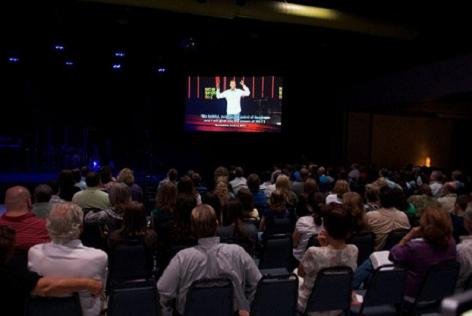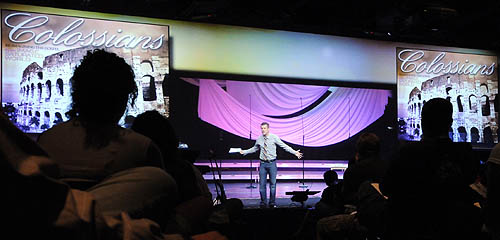 As evangelical churches vie to become bigger by use of business tactics, they’re outgrowing their buildings. As such, the multi-site church has sprung whole from the American business model.
As evangelical churches vie to become bigger by use of business tactics, they’re outgrowing their buildings. As such, the multi-site church has sprung whole from the American business model.
A multi-site church has a main campus and many smaller spawn called satellites that operate under the auspices of the parent church. (Vocab words are in italics.) The satellite church is sort of a sequel to the original. It’s of the same lineage but everyone really likes the first one better, though in Christian culture they won’t say it out loud. People prefer the original because that is where the charismatic pastor man who started the whole enterprise speaks live and in person.
 His title is teaching pastor, preaching pastor or lead pastor, and he very seldom appears in person at any of the satellite churches. The satellites are basically theaters sprinkled around a 50 mile radius (sometimes larger) as overflow reservoirs. At these satellites the lead pastor’s visage is beamed onto a big screen as he preaches live from the main campus. People assemble in the satellite buildings to sing worship songs, listen to the real live campus pastor make announcements, and then watch the main-attraction pastor speak via satellite. Everyone who attends accepts this arrangement as fine and even good.
His title is teaching pastor, preaching pastor or lead pastor, and he very seldom appears in person at any of the satellite churches. The satellites are basically theaters sprinkled around a 50 mile radius (sometimes larger) as overflow reservoirs. At these satellites the lead pastor’s visage is beamed onto a big screen as he preaches live from the main campus. People assemble in the satellite buildings to sing worship songs, listen to the real live campus pastor make announcements, and then watch the main-attraction pastor speak via satellite. Everyone who attends accepts this arrangement as fine and even good.
When you see a pastor preaching on a big screen, there is a .0042% chance you would ever be granted a personal meeting with him. Again, this is accepted by the general populace as okay. The New Testament pastors understood they had a shepherding role over the church and felt a personal relationship with each of the members was vitally important, but this aspect of the ancient church is falling by the wayside as technology advances. What can I say, holograms are pretty cool.

